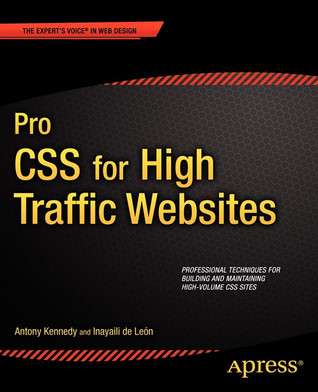Pro CSS for High Traffic Websites Review

This book is as described and more. It focuses on a variety of aspects regarding front-end web development at the enterprise level. This includes team hierarchy, individual roles, tools, documentation, frameworks and methodologies so it goes beyond coding but it’s equally technical in nature. This is definitely not a beginner’s book because of the technical details so it’s possible to be overwhelmed with the amount of content. Any intermediate to advance front-end web developer will find this book useful and without doubt improve their skills even it’s just minor details. These include:
-why camel case is preferred
-why you shouldn’t use specific hacks but rather alternatives
-which tools make coding more efficient
You can find good examples, although brief, and pragmatic recommendations for real world situations. I believe this improves learning but it is not organized well if it were to be a reference book. However, you can skip to any chapter without feeling lost.
Chapter 2 summary:
-Where to find good style guides
-Why constancy is better than quality
-Why formatting your code makes a difference
-Code Commenting & Documentation standards
-Why name spacing is important in high traffic websites
Chapter 3 summary:
-Definition and explanation of Cascading in CSS
-How the box model differs in different browsers and how its new properties in CSS3
-Specific hacks for different browsers
-CSS Expression you may not have heard of
-Usage of media queries and how they are applied
-Explaining how HTML conditional comments should be used
Chapter 4 summary:
-Creating layout with frameworks
-How layouts can be grid systems
-How Eric Meyer’s Reset styles can be more than necessary
-How to make CSS object-oriented using LESS and SASS
Besides those topics, chapter 4 also describes useless concepts that cannot be predicted but more so inevitable when working on lengthy stylesheets for those high traffic websites. To be specific they apply to 3rd-party code and are referred to as “Defensive and Fragile” CSS. Having personally worked on high volume websites using 3rd-party code, it is almost impossible to change CSS properties because you would have to edit the core of the 3rd party code. This is an issue because 3rd party code or framework generates numbered classes and ids which are difficult to isolate. You’ll want to avoid editing the core for risk of breaking it or invalidating it if another developer chooses to use a newer version. That’s where the !important statement comes in hand.
Chapter 5 summary:
…is mostly about design and discusses more of the visual aspect including colors, units and fonts rather than code. It is good to understand the concepts because it is the code that renders the designs. Web designers should be aware of this and I highly recommend this information to designers that don’t code, because those are the designers that can make a developer’s job really difficult. If a designer shows a concept of a pig flying and it’s sold to the client, it becomes the developer’s responsibility to actually make that pig fly!
Chapter 6 summary:
This chapter is all about accessibility and non-traditional navigation so if you are coding for disabled people or the government, this section is for you.
Chapter 7 summary:
If you’re optimizing websites for mobile and other devices including printers then you’ll find the specific details of html tags and properties essential to making websites render better on devices with different screen sizes and such.
Chapter 8 summary:
Here’s where you’ll find the nitty-gritty details how code effects performance including compression, caching, HTTP calls and image optimization.

